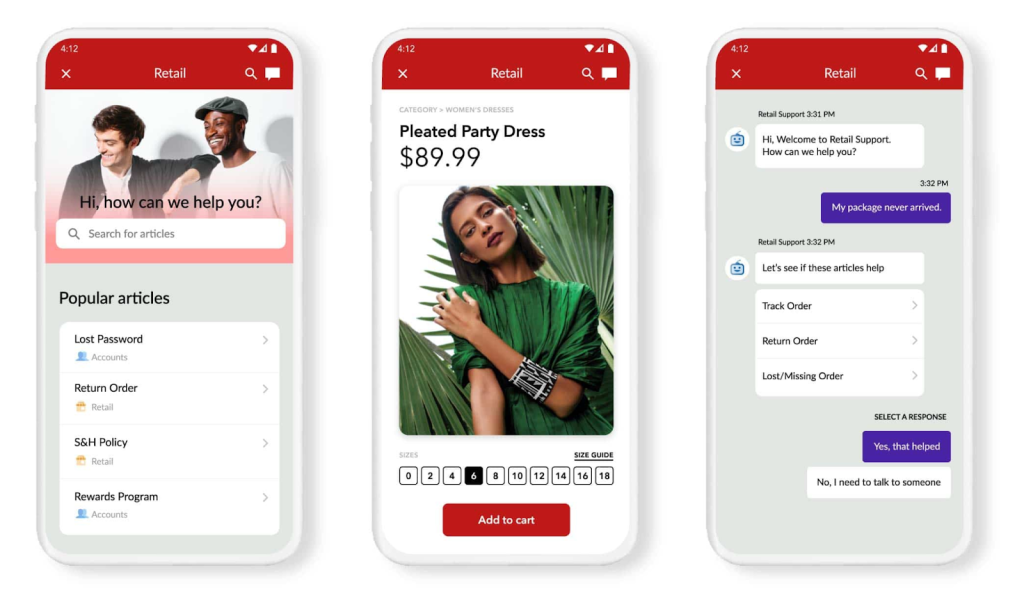37 percent of customers say they would prefer to get immediate assistance from a chatbot over waiting just three minutes for a human.
We’re all becoming used to interacting with automation. In fact, we often prefer it. From Siri to Alexa to automatic bill payment, automation has become an ingrained part of the way we live our daily lives.
With customer service, too, automation is becoming an expectation. When Helpshift surveyed 2,353 consumers in 2019, we found that 54 percent of them thought customer service had improved in just a year. Probably not a coincidence that we also noted a 20 percent increase in chatbots handling message-based issues. Automation is becoming standard to making customer support organizations more efficient, accessible, and successful.
However, our customers saw the highest CSAT scores when they used a combination of bots and human agents. This is a telling metric. While it may sometimes seem that we’re on our way to full-bore automation, the reality is that fully automated customer service is probably going to remain a myth for now. People remain core to the success of customer service. Automation supports, rather than replaces, human effort and engagement.
Still, the allure of fully automated customer service is strong.
What would fully automated customer service even look like?
From a brand perspective, fully automated customer service is an enticing concept. It would eliminate not just human-resource costs but human errors as well. And fully automated customer service would be infinitely scalable. If a chatbot can answer one customer’s inquiry, it can reply just as easily to 100 customers — even 1,000 or 10,000. Instead of needing a bustling call center, you only need one “robot.”
Another major benefit of automated customer service technology is that it provides insightful data and analytics on customer support. If you know exactly how many customers are contacting you about a particular issue, that information lends itself well to product and feature review and design, for instance.
From the customer perspective, automated customer service is equally thrilling. The ability to get answers quickly, at any time of day or night, without having to wait on hold or navigate a conversation with another human, is an excellent notion. Customer service automation has enabled companies to classify ticket routing more intelligently and automatically route those issues to the right person or bot so customers get served more efficiently and quickly. In many cases, automation also enables customers to answer their own questions and solve their own problems.
But automated customer service is one thing. Fully automated customer service is another.
Where fully automated customer service fails
When automation fails to be helpful, customers become frustrated. We’ve all been there — repeating “representative!” into an automated phone system in increasingly louder tones until we reach a human. While many aspects of customer service can benefit tremendously from automation in strategic areas, at the end of the day, most companies find that there will always be situations that call for human-to-human conversation.
The ideal scenario is that your automated customer service efforts align smoothly and work effortlessly with your human support. For instance, when a conversation with a bot is not resolving a customer’s issue, that customer is passed along to a support agent who already knows the background and details of the issue and can jump right in without having to play catch-up.
So, fully automated customer service may not be an achievable goal for most companies and there may always be a use case for human support. But it is realistic to fully automate certain aspects of customer service. Let’s take a closer look.
The aspects of customer service that can benefit from being fully automated
Some areas of customer service are optimized when automated. They simply perform better, with a higher rate of successful outcomes for customers, and the ability for brands to streamline the customer support operation. For instance:
- Chatbots — Chatbots on websites and within apps enable customers to connect with brands instantly. The gratification that comes with instantaneous response is backed up by the ability to get answers quickly, too.
- Self-service options — Connecting chatbots to a brand’s knowledge base enables customers to self-serve to their own solutions quickly. This is optimized when a chatbot can leverage AI to parse the customer’s question, regardless of the wording, and respond with accurate links to FAQ pages and articles.
- Intelligent issue classification — AI-powered issue classification helps route customer queries to the right bot or agent immediately. Helpshift’s classification engine, for instance, applies machine learning and AI algorithms to accurately predict which category an incoming issue belongs to, then assigns it to the right agent.
Rapid advances in these types of technologies are leading to increasing automation in the customer support industry and improving customer support in general. So the growing trend of automated customer service is probably not going to slow down anytime soon. But to optimize customer service efforts, most companies are looking for a balance between automation and human excellence. Fully automated customer service, as alluring as it sounds, will remain a myth for the time being.
Want to learn more?
- Customer Service Glossary Article: What is Issue Classification?
- Additional Solution Information: Helpshift Powered Service and Deflection




